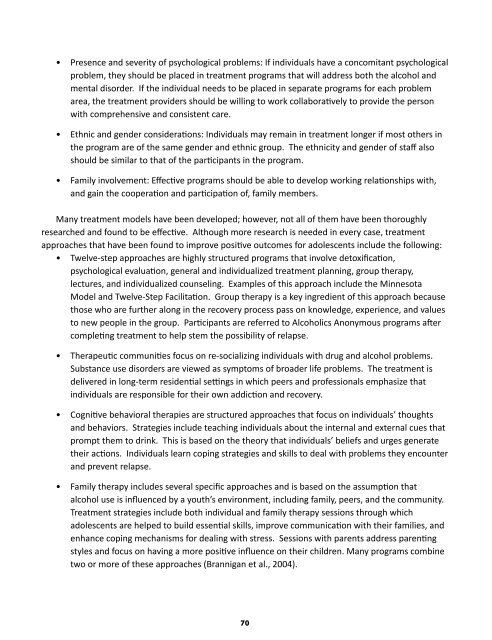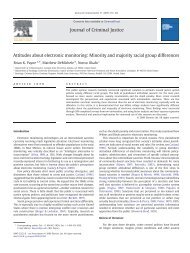Intervention Principles and Practice Guidelines for - Underage ...
Intervention Principles and Practice Guidelines for - Underage ...
Intervention Principles and Practice Guidelines for - Underage ...
You also want an ePaper? Increase the reach of your titles
YUMPU automatically turns print PDFs into web optimized ePapers that Google loves.
• Presence <strong>and</strong> severity of psychological problems: If individuals have a concomitant psychological<br />
problem, they should be placed in treatment programs that will address both the alcohol <strong>and</strong><br />
mental disorder. If the individual needs to be placed in separate programs <strong>for</strong> each problem<br />
area, the treatment providers should be willing to work collaboratively to provide the person<br />
with comprehensive <strong>and</strong> consistent care.<br />
• Ethnic <strong>and</strong> gender considerations: Individuals may remain in treatment longer if most others in<br />
the program are of the same gender <strong>and</strong> ethnic group. The ethnicity <strong>and</strong> gender of staff also<br />
should be similar to that of the participants in the program.<br />
• Family involvement: Effective programs should be able to develop working relationships with,<br />
<strong>and</strong> gain the cooperation <strong>and</strong> participation of, family members.<br />
Many treatment models have been developed; however, not all of them have been thoroughly<br />
researched <strong>and</strong> found to be effective. Although more research is needed in every case, treatment<br />
approaches that have been found to improve positive outcomes <strong>for</strong> adolescents include the following:<br />
• Twelve-step approaches are highly structured programs that involve detoxification,<br />
psychological evaluation, general <strong>and</strong> individualized treatment planning, group therapy,<br />
lectures, <strong>and</strong> individualized counseling. Examples of this approach include the Minnesota<br />
Model <strong>and</strong> Twelve-Step Facilitation. Group therapy is a key ingredient of this approach because<br />
those who are further along in the recovery process pass on knowledge, experience, <strong>and</strong> values<br />
to new people in the group. Participants are referred to Alcoholics Anonymous programs after<br />
completing treatment to help stem the possibility of relapse.<br />
• Therapeutic communities focus on re-socializing individuals with drug <strong>and</strong> alcohol problems.<br />
Substance use disorders are viewed as symptoms of broader life problems. The treatment is<br />
delivered in long-term residential settings in which peers <strong>and</strong> professionals emphasize that<br />
individuals are responsible <strong>for</strong> their own addiction <strong>and</strong> recovery.<br />
• Cognitive behavioral therapies are structured approaches that focus on individuals’ thoughts<br />
<strong>and</strong> behaviors. Strategies include teaching individuals about the internal <strong>and</strong> external cues that<br />
prompt them to drink. This is based on the theory that individuals’ beliefs <strong>and</strong> urges generate<br />
their actions. Individuals learn coping strategies <strong>and</strong> skills to deal with problems they encounter<br />
<strong>and</strong> prevent relapse.<br />
• Family therapy includes several specific approaches <strong>and</strong> is based on the assumption that<br />
alcohol use is influenced by a youth’s environment, including family, peers, <strong>and</strong> the community.<br />
Treatment strategies include both individual <strong>and</strong> family therapy sessions through which<br />
adolescents are helped to build essential skills, improve communication with their families, <strong>and</strong><br />
enhance coping mechanisms <strong>for</strong> dealing with stress. Sessions with parents address parenting<br />
styles <strong>and</strong> focus on having a more positive influence on their children. Many programs combine<br />
two or more of these approaches (Brannigan et al., 2004).<br />
70

















